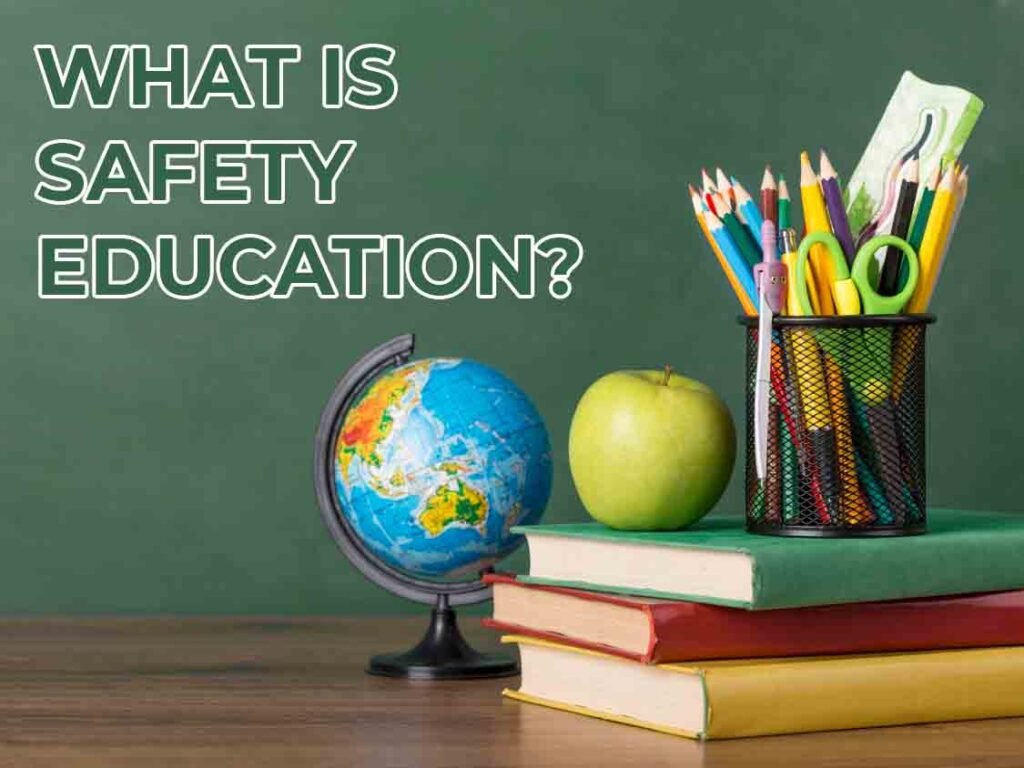Introduction
Our life depends on safety education since it aims to provide individuals with knowledge, skills, and awareness so they may be aware of the several hazards they could come across in different surroundings. Safety education is aimed to give people the tools and knowledge needed to avoid mistakes, react effectively in an emergency, and build safer communities regardless of public areas, businesses, or classrooms. Through education, we may greatly lower the likelihood of injuries, deaths, and other negative events by so encouraging a culture of safety for everybody.
One cannot stress the value of safety education since it forms the basis of a proactive attitude to safety. Safety education includes a wide range of issues catered to various age groups and environments, from teaching youngsters about the need to wear seat belts to training personnel on how to handle dangerous chemicals. It underlines the requirement of awareness, readiness, and responsible behavior, enabling people to take control of their safety as well as that of those close by. Safety education is a must-have tool for creating a strong and knowledgeable society in a world where unanticipated hazards might strike at any moment.
Background History
For millennia, human society has depended critically on safety education; nevertheless, its shape and emphasis have changed with time. Safety instruction was first informal and passed down over generations, mostly by family traditions and community teachings. People picked up safety tips tailored to their surroundings, including how to handle fire, guard against wild animals, and weather survival techniques. The demand for a more organized approach to safety education evolved along with civilizations.
Particularly, the Industrial Revolution brought about notable changes since new technologies presented new hazards. Safety courses started to be taught in schools, and rules to guarantee public safety started to be created by the government. Safety education nowadays is a broad field including many facets, from physical safety to digital security, and it is vital for people of all ages.
The Core Components of Safety Education
The foundation of safety education is made up of multiple essential elements that guarantee people are prepared to manage a range of dangers. These elements consist of conduct, knowledge, skills, and awareness. In any environment, awareness means recognizing potential hazards. A person’s knowledge is their awareness of the threats associated with these hazards, as well as the best ways to eliminate them. First aid, fire safety, and evacuation procedures constitute among the useful knowledge and abilities needed to manage crises.
Last but not least, conduct involves assuming a safety-first mentality, in which people continuously use their abilities and expertise to avert mishaps and injuries. Together, these elements form an all-encompassing framework for safety education that may be customized for use in a variety of settings, including communities, workplaces, and educational institutions.
The Implementation of Safety Education in Schools
Safety instruction is implemented in part in schools. Children are taught fundamental safety concepts, including crossing the street properly, the need to wear seat belts, and what to do in case of a fire from a young age. The extent of safety instruction covers as students advance through their studies to encompass subjects including internet safety, bullying prevention, and emergency readiness. Safety education is taught to teachers to be naturally included in many disciplines, therefore augmenting their instructional process.
Schools also frequently work with nearby emergency agencies to run exercises and simulations, therefore giving pupils practical practice managing possible crises. The intention is to provide pupils with the knowledge and abilities required to defend others and themselves, both inside and outside of the classroom.
Safety Education in the Workplace
In the workplace, where workers run a range of hazards based on their sector, safety education is equally vital. Employers have both moral and legal responsibilities to create a safe workplace, which includes training staff members on how to spot and minimize hazards there may be. Usually starting with onboarding training, this education covers the safety policies, emergency protocols, and particular hazards connected to their positions for newly hired employees.
Common are also frequent seminars and training courses that guarantee staff members remain current with the newest safety procedures. Safety education in high-risk sectors, including manufacturing or construction, could involve specific instruction on equipment usage, chemical handling, and personal protective equipment (PPE). Giving safety instruction top priority will help businesses lower workplace mishaps, raise staff welfare, and increase general production.
Programs for Community-Based Safety Education
Programs for community-based safety education are meant to reach people outside of conventional environments like companies and classrooms. Often emphasizing certain concerns pertinent to the community, such as road safety, disaster readiness, or crime prevention, these initiatives Local governments, non-profits, and community organizations typically collaborate to develop and deliver these programs, which may include workshops, seminars, and public awareness campaigns.
For a bike safety event, for instance, a community might plan where attendees discover the need to wear helmets and respect traffic regulations. Reaching varied demographics, including elders, low-income families, and non-English speakers who would not have access to safety instruction via other means, these programs are absolutely vital. These initiatives help to build safer surroundings for everyone by encouraging a culture of safety inside the society.
Creating Community Connections
One of the most important components of good safety instruction is building strong bonds inside communities. Working together, people and businesses inside a community can distribute resources, expertise, and support to improve general safety. Neighborhood watch programs, whereby neighbors band together to observe and document suspicious activity, or alliances between local fire departments and schools to do safety drills are just two possible ways this cooperation may take place.
Building these relationships helps communities to have a more unified approach to safety, therefore guaranteeing that everyone is ready to handle crises and informed. Moreover, these ties might assist in spotting and solving particular safety issues that might be particular to the neighborhood, including environmental risks or high crime rates. Safety education thus becomes a group endeavor benefiting all parts of society.
Providing Safety Education to Children and Teens
Particularly vulnerable to safety hazards are children and teenagers; hence, focused safety education for these age groups is rather important. Children are taught fundamental safety lessons at a young age, including not chatting to strangers, looking both ways before crossing the street, and the risks of playing with fire. Safety education’s emphasis moves as people become older to more difficult problems, including online safety, peer pressure, and mental health awareness.
Although schools usually take the front stage in providing this instruction, parents and other caregivers also have a vital role. Children and adults should have open lines of contact so young people may ask questions and voice worries about their safety. For this age range, interactive learning strategies such as games and role-playing can also help to make safety teaching more interesting and successful.
Education About Digital Safety
In the always digital environment of today, knowledge of digital safety is more crucial than ever. Among the topics taught in digital safety education are online privacy, cyberbullying, identity theft, and proper social media use. Both children and adults should understand the risks associated with internet access and how to protect against any threats. People should know, for instance, the need to control their digital footprint, spot phishing efforts, and have strong, distinctive passwords for several accounts.
Through seminars, workshops, and online materials, schools, businesses, and community organizations frequently offer digital safety instruction. Those who are educated about digital safety can use the advantages of technology while lowering the hazards.
Regulations Relating to Health and Safety
Safety education depends critically on health and safety rules, which create a legal framework guaranteeing people’s welfare in different surroundings. Government organizations such as the Occupational Safety and Health Administration (OSHA) in the United States enforce these rules for workplace safety. Regulations span a broad spectrum, including ergonomics, fire safety, management of hazardous products, and emergency planning.
Organizations must comply with these rules and provide training to guarantee staff members grasp and apply safety procedures. Apart from rules in the workplace, health and safety laws cover public areas, educational institutions, and households, therefore guaranteeing everyone has access to safe surroundings. Effective safety instruction depends critically on an awareness of and adherence to these rules.
Opportunities and Challenges in Safety Education
Though it presents many chances to improve public well-being, safety education also presents certain difficulties. One of the primary chances is the possibility to reach a larger audience by using technology.
New, interesting approaches to providing safety education accessible and interesting are offered via online courses, smartphone apps, and virtual simulations. Safety education initiatives may thus be less effective in the face of obstacles, including lack of money, opposition to change, and different degrees of literacy. Furthermore challenging the delivery of consistent safety education across many communities are language hurdles and cultural variances.
Developing adaptable, inclusive programs that may be fit to the demands of various communities would help one to overcome these difficulties. By tackling these issues, safety education may keep developing and get better, so saving lives and lowering injuries.
Role of Technology in Safety Education
Safety education depends on technology more and more since it offers fresh tools and approaches for learning and training. Simulations of virtual reality (VR) and augmented reality (AR) let people experience realistic situations in a controlled environment, like learning how to run sophisticated machinery or emergency evacuation plans.
Safety education is more easily available thanks to online platforms and smartphone apps, which let people learn on their own schedule and speed. Technology also makes it possible to gather and examine information on safety events, helping to spot trends and enhance safety procedures. Technology can be included in safety education to provide businesses with more efficient, interesting, and tailored learning opportunities that improve safety results.
Mobile Apps for Safety
Offering a practical and easily available means for people to understand and implement safety concepts, mobile apps have grown to be a common tool for safety education. From digital safety and workplace safety to first aid and emergency readiness, these applications may address a broad spectrum of subjects. For instance, some programs offer detailed directions on how to do CPR, while others give advice on how to keep safe while on travel. Users of mobile apps can also be informed of possible hazards including nearby criminal events or strong storms.
Mobile apps’ interactive character makes them a useful instrument for supporting safety education since users may test their knowledge in real-time and practice abilities. The use of safety education applications is probably going to increase as mobile technology grows since more individuals will have the means necessary to remain safe.
Future Trends in Safety Education
As safety education develops, a number of important trends are probably going to define its course. One of the major trend is the extensive use of technology, especially in the form of digital and immersive reality, to create engaging learning experiences. Another trend is the growing attention on mental health and well-being as a natural component of safety education since emotional and psychological safety are equally essential as physical safety.
More customized safety education, in which training is catered to the particular needs and hazards of people or groups, is also in demand. This can entail offering focused solutions and spotting high-risk behaviors using data analytics. Finally, the globalization of safety education, with programs and resources being shared across borders, will continue to play a significant role in raising safety standards worldwide. Safety education can remain relevant and successful in an always shifting environment by leading ahead of these trends.
Conclusion
Modern living requires safety education since it helps people to negotiate the hazards and obstacles they encounter in different surroundings. Safety education offers the knowledge, abilities, and awareness required to safeguard others and oneself, from homes and digital environments to businesses and classrooms. Safety education will change as new hazards arise, and technology develops, presenting fresh chances for learning and development. Giving safety education a priority helps us to build stronger, healthier, safer communities.
FAQs
1. What is the main purpose of safety education?
Safety education is designed largely to provide individuals with the knowledge, tools, and awareness needed to avoid mishaps, accidents, and other problems in various situations.
2. How does safety education benefit the workplace?
By ensuring that safety policies are correctly followed and executed, safety education in the field enhances employee well-being, helps reduce accidents and injuries, and increases productivity.
3. What are instances of community-based safety initiatives?
Programs for community-based safety education range from road safety campaigns to disaster preparedness seminars to neighborhood watch systems.
4. Why is digital safety education important?
Digital safety education is utterly essential since it helps people secure themselves from online threats such online bullying, identifying fraudulent activities, and privacy violations.
5. What role does technology play in the future of safety education?
The future of safety education will be greatly shaped by technology since it offers fresh tools and approaches to improve learning and training experiences, such virtual reality simulations and mobile apps.






















